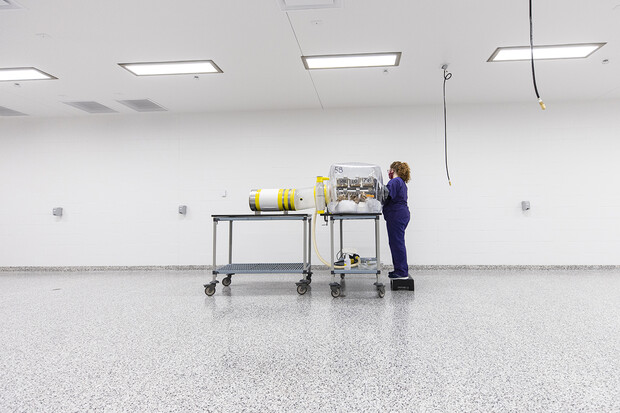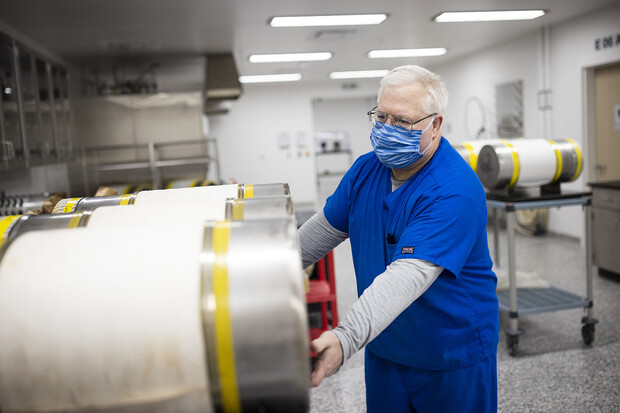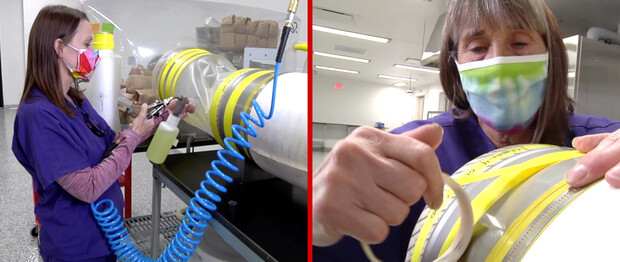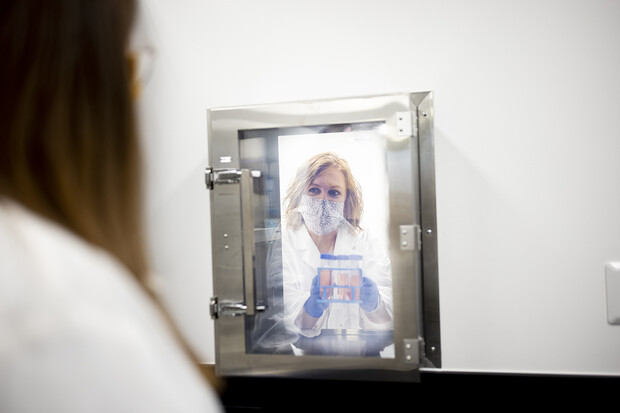Scott Schrage, January 4, 2021
Mouse house: Germ-free facility puts Nebraska U at forefront of microbiome research
As appealing as the idea of a germ-free facility has become, Nebraska’s Amanda Ramer-Tait and her colleagues weren’t exactly anticipating a pandemic when they proposed it a few years ago.
The germs they focus on are bacterial, not viral, and more likely to help than harm. Besides, the facility isn’t designed to quarantine people — though the research conducted at the newly unveiled, nearly 10,000-square-foot Gnotobiotic Mouse Facility ultimately aims to benefit them.

The intestinal tract of an adult human can house about 100 trillion bacteria representing hundreds of species, making the gut an ultra-dense ecosystem — a microbiome — whose importance becomes more apparent with the accumulating evidence of each passing year. It’s become undeniable: The composition and condition of the microbiome influence a person’s gastrointestinal health, immune system and, in ways that remain murky, the functioning of systems ranging from the cardiovascular to the neurological. If the brain remains the most vital-but-mysterious chamber of secrets in the body, the gut has recently surged into second place.
As with any complex system, understanding the whole of the microbiome starts with understanding its parts — in this case, individual species of bacteria. Untangling the effects that a given species might have on its host, human or otherwise, often means isolating it from its many neighbors. Sometimes, when researchers have reason to suspect that a few species might be interacting to produce effects that none would on its own, the untangling can start with combining just those species and observing the results.
Unfortunately, bacteria are almost everywhere — except in the relatively few facilities where careful engineering and unfailing, unceasing sterilization manage to ward them off. There, mice can be raised free of any and all bacteria, transforming their GI tracts into living but sterile mini-laboratories where the absence or presence of bacterial species can be controlled, and their effects measured, at a pace and in ways that would be impractical with human subjects.

By the time Ramer-Tait arrived at the University of Nebraska–Lincoln, in 2012, some of her new colleagues had already been working with germ-free mice for four years. They were doing so on East Campus, where about 1,200 square feet of non-contiguous space had been dedicated to the work. Over the next eight years, Ramer-Tait helped nearly triple the number of mice the program could accommodate. But she and her fellow researchers knew they could be doing so much more with a bit, or ideally a lot, more room.

Ramer-Tait
“Space was at a premium, and we had no growth capacity whatsoever,” said Ramer-Tait, associate professor of food science and technology and director of the Nebraska Gnotobiotic Mouse Program. “I was turning people away for projects. I would have to say, ‘We just can’t do it,’ or, ‘We can do it, but you’re going to have to wait for a really long time.’”
That need for space became even more pressing with the launch of the Nebraska Food for Health Center in 2016. Led by Andrew Benson, the center’s researchers want to understand how certain foods, compounds and molecules can alter a person’s microbiome for the better — especially by introducing and establishing bacteria that might reduce the risk of diabetes, heart disease, possibly even cancers or dementia.
Getting to that point will demand many, many studies, some of which are underway. The essence of the center’s process goes something like this: Simulate the digestion of a grain, legume or other crop via an automated system. Take bacterial communities from the stool of human subjects and grow them on the digested remains of those respective food crops, roughly recreating the food-microbiome interactions taking place in the human gut. Then, use advanced data-analysis techniques to search for differences in the growth of those bacterial ecosystems.
Those differences help Benson and his colleagues tease apart which food-based molecules, from which crop lines, show the most promise for shaping the human microbiome to treat or even prevent diseases. But the pipeline between recognizing that promise and testing it in humans is a long, fraught one. And it’s full of mice.

“With the creation of the Nebraska Food for Health Center, we assembled specialized resources to discover, develop and translate dietary innovations for altering the gut microbiome to improve health,” Ramer-Tait said. “Germ-free mice are critical to this mission, because we can ‘humanize’ them with the same human stool microbiomes that we test with food crops in the laboratory. Leading crop lines and molecules will first be evaluated in germ-free mice before moving forward for feeding to healthy humans. These mice represent an integral step in a pipeline that eventually narrows our initial findings to the best candidates for medical food interventions in patients.
“Despite my excitement, the logistics of feeding a large number of individual crop lines to many germ-free mice harboring unique human microbiomes was just overwhelming. It made my head spin to think about how we would do all that in the limited space we had and continue to support all the other collaborations and projects that needed our facility.”
Undertaking more studies meant more room, which meant more infrastructure, which meant money. So Ramer-Tait, Benson and the center teamed with the University of Nebraska Foundation. Four years and $5 million in private donor support later, the researchers are celebrating the opening of the Gnotobiotic Mouse Facility, which sits adjacent to the previously allotted space.
The pandemic turned what would have been a grand opening into a much smaller affair, Ramer-Tait said, but it hasn’t dimmed her enthusiasm.
“We’re the only food science department in the United States that has a gnotobiotic mouse program,” she said. “You typically find these facilities at major medical schools.
“Our new facility can now house 50 isolators, plus specialized equipment. I would say this puts us in the top 15 around the world for footprint and scale.”

Fittingly, though, it’s as much the guts as the footprint of the new space that should speed the team’s progress toward cracking the secrets of the microbiome. Given that virtually all gut bacteria die in the presence of oxygen, the facility’s laboratory houses a sealed, oxygen-free chamber to culture individual bacterial species from humans or preserve an entire gut microbiome. Team members can remove those bacteria via an airlock, send them into a pass-through that connects the laboratory with a procedure room, then go gown up in a nearby locker room before entering that procedure room, where they feed the bacteria to the germ-free mice.
The mice themselves are getting upgraded digs, too. Before, Ramer-Tait’s team relied on sealed isolators that could hold up to 18 cages apiece. Because those cages weren’t isolated from one another, though, any mice kept in the same isolator would need to be fed the same bacterial species to prevent cross-contamination, limiting how fast the team could test new ones. But with recent funding from the U.S. Department of Agriculture, the team will purchase a new system that can hold up to 96 cages — each of which also acts as its own isolator. That logistical multiplier alone will accelerate the rate at which studies can progress, Ramer-Tait said.

“If you want to screen microbiomes from 10 different humans for how they each respond to 10 different lines of maize or sorghum, then you’ll need a lot of isolators to complete that study,” she said. “It was impractical. You’d never do it. But now we can facilitate that work with this piece of equipment and evaluate hundreds of microbiome-by-diet interactions.”
The extra 3,500 square feet devoted to housing the mice will also push the pace, allowing the team to support the center while taking on more collaborative projects with the University of Nebraska Medical Center and other scientists in the United States, Canada and elsewhere.
Ramer-Tait’s team moved the mice into their spacious new home just before Christmas — putting a bow on a capital project long in the making.
“We are incredibly fortunate to have this resource,” Ramer-Tait said. “There should be a lot of pride in the fact that we have something like this in Nebraska.”





